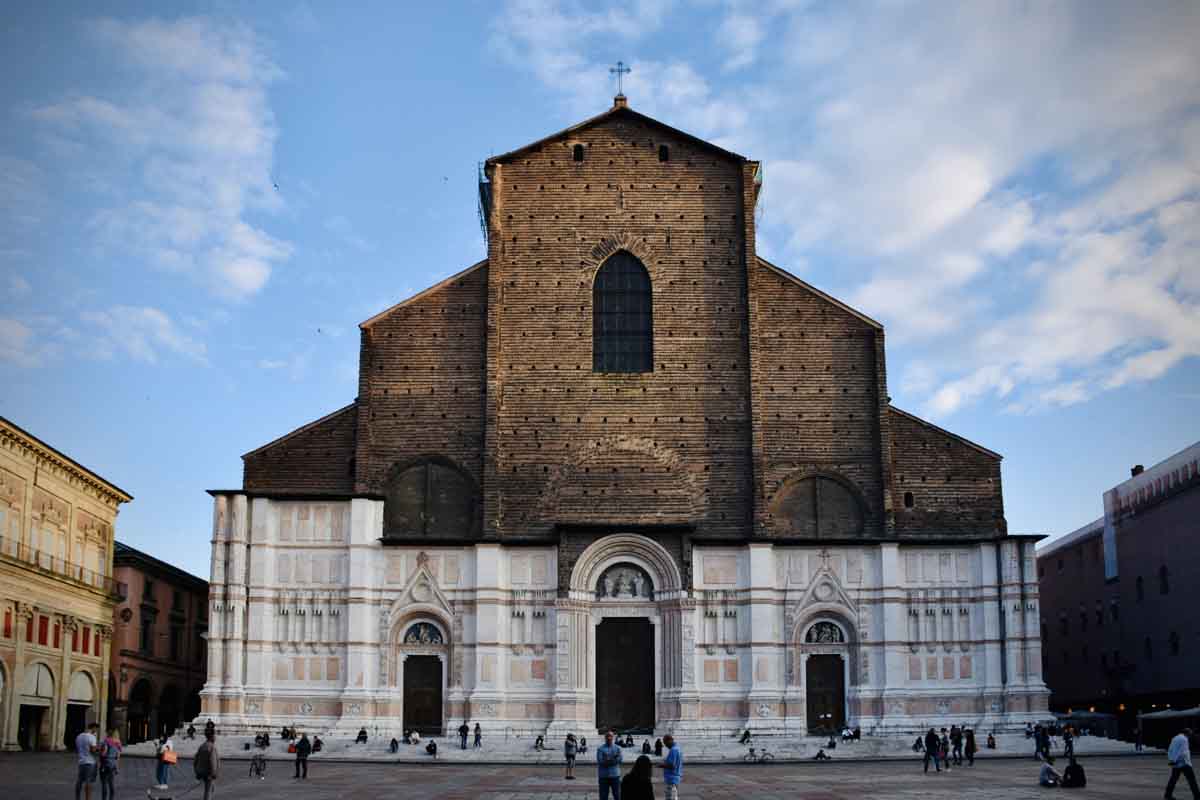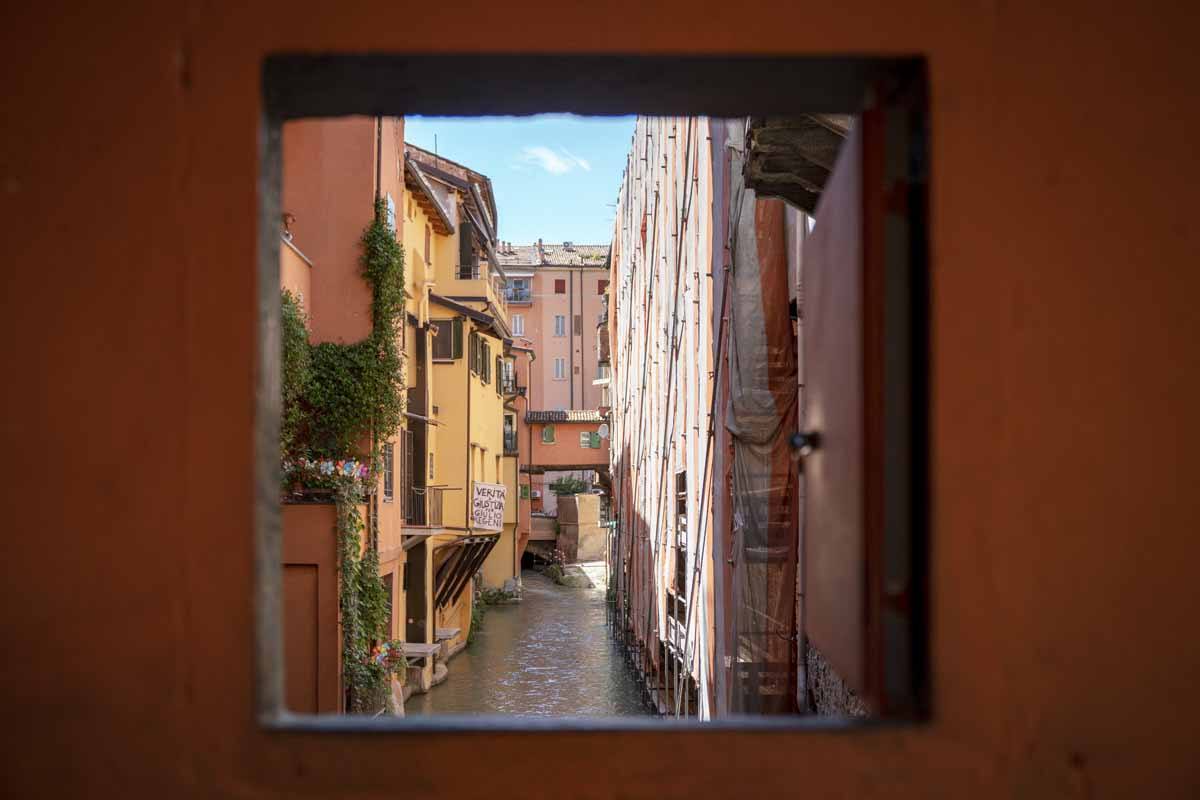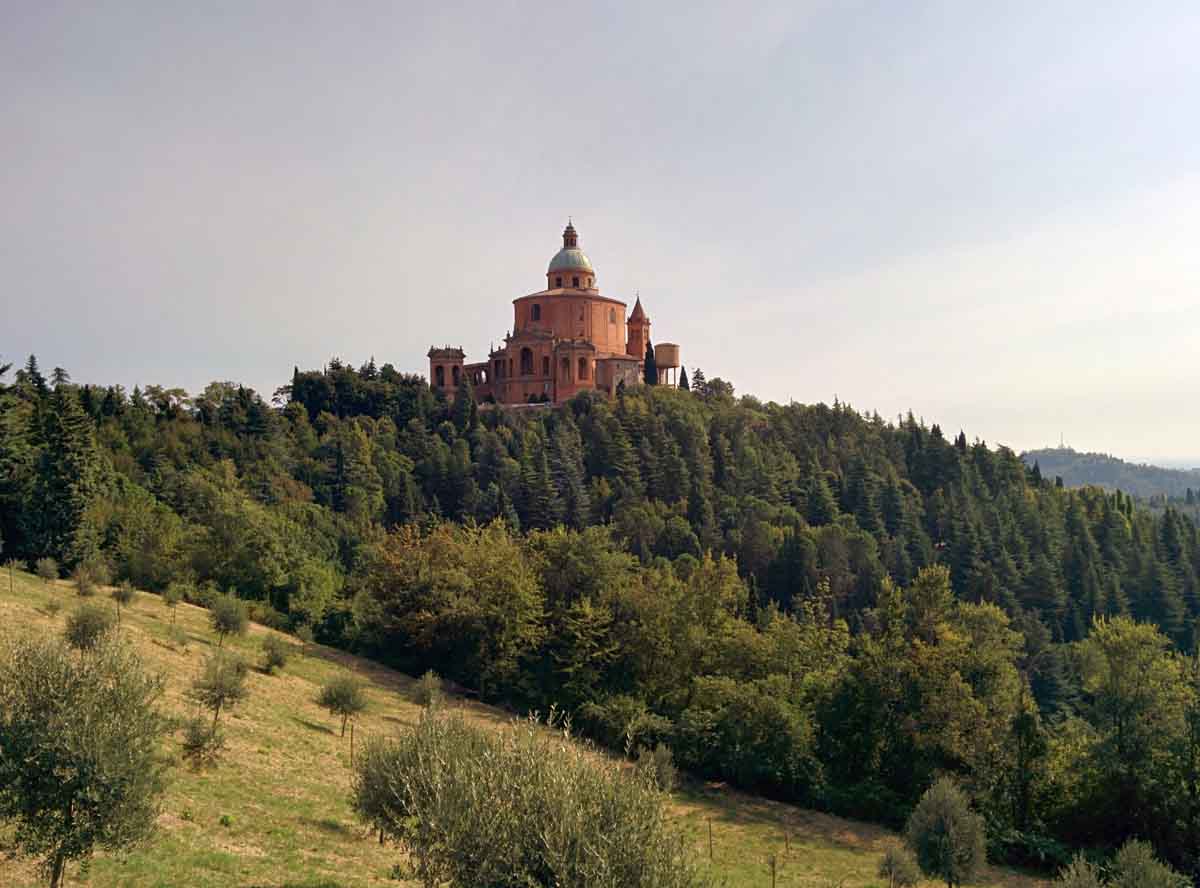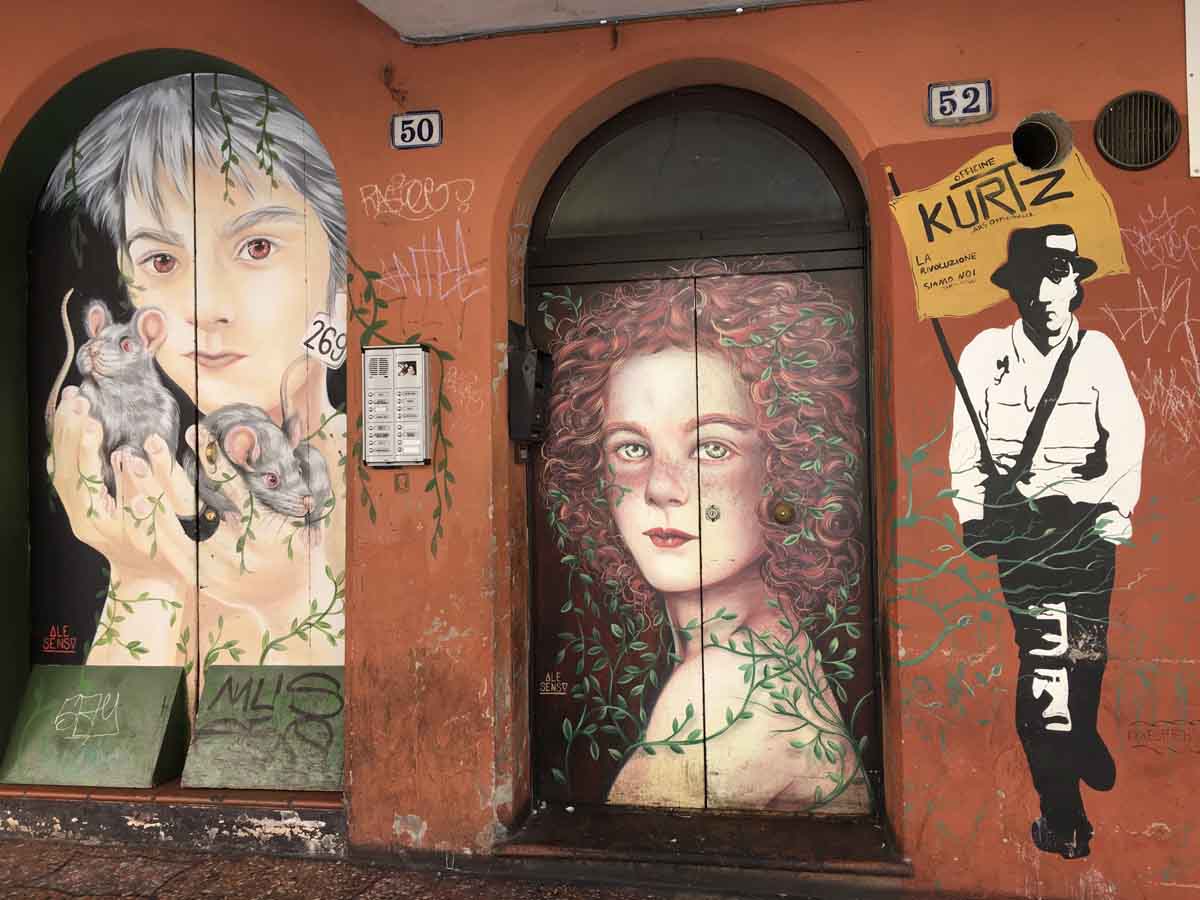Bologna is one of our favourite cities and it’s perfect for a weekend or a day trip. Read this article and follow our itinerary to spend the perfect one day in Bologna!
Would you like to explore with a local guide? Book one of these quick and easy Bologna tours!
We love booking tours with GetYourGuide – the company offers a variety of activities, flexible booking, and 24/7 support!
- Bologna City Center Walking Tour – all the main sights on this best-selling tour!
- Bologna: Walking Food Tour with a Local Guide – yes, Bologna is all about FOOD!
- Bologna: Tastes and Traditions Food Tour with Market Visit – market visit and stops in local restaurants <3
- Bologna 3-Hour Secret Food Tour – discover local-only places!
- Bologna to San Luca Basilica by Train and Food Tasting – combine traditional food and a visit to Bologna’s most iconic sight
Gone are the days when you could say Bologna was offbeat and a ‘hidden secret’. The capital of Emilia-Romagna is well known and visited by tourists from all over the world, thanks to its easy flight connections and incredible food. After all, its nickname is ‘La Grassa’ (the fat one).
However, Bologna is far less busy than other big Italian cities like Rome, Florence, and Venice. This becomes especially noticeable during the high season – you won’t find hordes of tourists, making it pleasant to walk around. Add to this the fact that Bologna has a large university student population, and when the summer break rolls in, most of them return to their hometown.
To sum up, Bologna is a pleasant destination to discover year-round. It’s very easy to reach as a day trip from Florence, Milan and Rome, being located on Italy’s main high-speed rail line. We visited Bologna dozens of times over the years and so we’ve put this itinerary together for 24 hours in Bologna, perfect for a 1-day trip!
Bologna in 1 Day – Practical Info
How to Get to Bologna
The best way to reach Bologna, whether you are planning to spend 24 hours or longer, is definitely by train. Bologna sits right in the middle of the Milan-Rome high-speed rail line, and also has fast trains to Venice. You can easily buy train tickets on the Trenitalia or Italo websites, and see which one has better fares. Travel time from Italy’s main cities are as follows:
- Milan: 1 hour
- Venice: 1.30 hours
- Florence: 1 hour
- Rome: 2/2.30 hours
How to Get Around Bologna
The entire one day in Bologna itinerary described in this article is walkable, taking 20 mins max between destinations. The only exception is the climb up to San Luca, which is mainly uphill and can take over an hour. If you don’t feel like it, you can take buses or a little tourist train all the way up to the top of the hill.
Best Time to Visit Bologna
Bologna is definitely a year-round destination, with positive and negative sides to visiting in all seasons. In winter, the temperature is cold and it’s often foggy, but it’s a great time to indulge in Bolognese cuisine. Spring and autumn are probably the best times to visit Bologna, the weather is generally good and the temperatures are mild, so it’s perfect if you want to do some day trips from Bologna or cycle the Ciclovia del Sole, a great itinerary from Bologna.
Summers are very hot and the town is very quiet as most locals and students head out of town. It’s still a good time to visit, but some bars, shops and restaurants may be closed.
Is Bologna Safe?
Generally speaking, Bologna is as safe as other main Italian cities. Pickpocketing does occur, especially in crowded areas and around the train station, and since Bologna is a very fun-loving city, it’s not uncommon to find young people who had a little too much to drink, especially at night around the University.
Basically, exercise the same levels of caution as you would in other European cities, don’t leave you belongings unattended, and you’ll be fine!
Are you planning a longer trip? Here are our 2 Days in Bologna itinerary and article about 3 days in Bologna (with local secrets!)
One Day in Bologna – Morning
9 AM – Walk down Via Indipendenza, Piazza Maggiore and Piazza del Nettuno

To get to the centre of Bologna from the train station, it’s an easy walk down Via Indipendenza, the city’s main shopping thoroughfare lined with shops for all tastes and budgets, from independent boutiques to chain stores. If you like shopping, this is your chance – otherwise keep walking until you get to Piazza Maggiore, about 20 minutes.
Piazza Maggiore is Bologna’s main square, measuring an impressive 115 meters in length and 60 meters in width, and has a raised central section, used to hold concerts, such as an outdoor film festival that entertains the citizens every summer.
The square offers a striking sight during the day and night, spectacular in its width that merges with the open skies. Piazza Maggiore is lined with several important buildings, such as the historical Palazzo Comunale dating back to 1290, and the Basilica of San Petronio.
Once in Piazza Maggiore, I recommend visiting this imposing Basilica, the largest in all of Bologna and yet still unfinished, as you can notice from the incomplete facade. Inside, you will be welcomed by the spectacular vaults of the nave. In the various chapels, you can admire several paintings, such as the Giudizio Universale, which may be the most important of the lot.
Attached to Piazza Maggiore, Piazza del Nettuno is famous for the fountain of the same name, built in the 16th century and still the city’s quintessential meeting place. If you have time, you can enter Sala Borsa, the city’s library and cultural center, below which you can see some excavations dating back to the 7th century BC.
10.30 AM – Climb Up the Torre degli Asinelli

The symbol of Bologna, the Asinelli and Garisenda Towers are truly a sight to behold. Although they are not the only towers still standing in Bologna, they are certainly the most eye-catching and imposing, as well as a sort of meeting point between all the main streets of the city.
Of the two, the Garisenda has suffered several structural failures, and in fact if observed from Via Zamboni it is possible to see how much it slopes. Yet, in the past the Garisenda was pretty important, not surprisingly it was mentioned several times by the poet Dante Alighieri.
The Asinelli Tower, an impressive 97.20 meters high construction, is the tallest inclined tower in Italy – actually taller than the uber-famous Leaning Tower of Pisa! Its 498 steps are a challenge for anyone who wants to get to the top, but the reward is worth the effort, as the top offers a spectacular view of the city. If you visit Bologna in spring or early summer, when it is not too hot, then I suggest climbing to the top!
However, if you’re studying you might want to give Torre degli Asinelli a pass. A local superstition says that if students climb to the top, they’ll never graduate. We warned you!
11.30 PM – Visit Piazza Santo Stefano and The Seven Churches
Once you get off the Asinelli Tower, head to Piazza delle Mercanzie and continue down Via Santo Stefano to find one of Bologna’s most unique squares. Its triangular shape gives it a distinctive perspective, especially when viewed from the Basilica of Santo Stefano.
Until two decades ago, the square was a gathering place for students, as well as a place of interest for tourists, as the elegant Corte Isolani underground passage can be accessed directly from the square.
The Basilica of Santo Stefano, also known as the Sette Chiese (Seven Churches), is a complex of churches dating back to 100 AD that has been expanded over the centuries. For example, the main structure, the Chiesa del Crocifisso is of Lombard origin, while the Basilica del Sepolcro was built in the 5th century by Bishop Petronio himself, the protector of Bologna (you can see his statue right below the Two Towers mentioned above).
Visiting feels like going on a journey through centuries of history, discovering different styles and cultures. Let’s continue our one day in Bologna itinerary with a hidden sight!
1 PM – Look Over the Finestrella sul Canale

Via Indipendenza is undoubtedly the city’s busiest area for shopping fans, but the backstreets connecting it to the University area have also much to offer. Among them, Via Piella has become famous for its Finestrella (small window), which allows a view of the Moline Canal, where you can catch a glimpse of Bologna’s own “Little Venice”, with some of the city’s old buildings resting on the water.
In front of the window there’s a terrace where you can see the canal in its entirety, while a few steps away you will find Biassanot, one of the city’s traditional restaurants where you can try typical Bolognese dishes such as tortellini in brodo and the legendary Petroniana breaded cutlet. We recommend making a reservation because the trattoria is very crowded, especially on weekends when it is literally stormed by tourists and citizens alike.
One day in Bologna – Lunch
1/2 PM – A stroll around the Quadrilatero
Close proximity to Piazza Maggiore, you’ll find the Quadrilatero, the city’s old trading district characterized by narrow streets and historic stores, some of which are also restaurants. Taking a stroll through the Quadrilatero is an excellent opportunity to buy some traditional cured meats, cheeses and other food specialties, however prices tend to be higher here as it’s quite a touristy area.
Similarly, in the Quadrilatero you can find several places to try Bolognese cuisine, for example in the Mercato di Mezzo, as well as in one of the restaurants located in Via delle Pescherie Vecchie. We recommend try fresh pasta, such as tagliatelle al ragù, or the legendary tortellini in brodo, perfect if tasted with a good Sangiovese wine or a Lambrusco sparkling wine.
Bologna is also famous for cold cuts, especially mortadella, to be enjoyed with crescentine and tigelle. The Quadrilatero is often crowded, so it is always best to make reservations. If you visit the city during the week, keep in mind that at lunch, restaurants will also be busy with professionals working in the area.
One day in Bologna – Afternoon
3 PM – Piazza San Domenico and Via Farini
After lunch, your one day in Bologna can continue with a nice, relaxing walk. Let’s head to a lesser-known destination for tourists, Piazza San Domenico, definitely “quieter” than the crowded Piazza San Francesco, Piazza Santo Stefano and Piazza Maggiore. The pavement made of cobblestones, similar to Piazza Santo Stefano, is particularly striking.
In the square, you can admire the Basilica of San Domenico; it was built between 1228 and 1240, with several restorations taking place from the 18th to the 20th century. From the square, you can easily get to Via Farini, where you can enter Galleria Cavour, the city’s luxury shopping center, filled with shops belonging to world-famous brands. Via Farini leads to Via D’Azeglio, a very nice street that extends to Piazza Maggiore.
4 PM – Basilica of San Francesco
If you are a fan of architecture, you cannot miss the Basilica of San Francesco. Not as famous as San Petronio, this church is striking for its exterior arches, made in the typical French Gothic style. The Roman-style façade dominates the square below, also a student hangout, and where the nightlife center of Via del Pratello usually converges, especially during spring and summer.
In the garden of the Basilica, it is possible to admire three funerary monuments of the glossatori, or Law professors who in the Middle Ages were responsible for analyzing ancient Roman law texts, making passages clearer through notes.
In front of the square, Bar De Marchi is another favorite spot for citizens to have an aperitif or a drink. Aroma Caffè located nearby is also a great place for afternoon coffee – they serve a selection of creative coffee-based drinks and also have single-origin coffees, available as espresso or filter coffee.
5/7 PM – A Visit to San Luca

Let’s continue this 24-hour Bologna itinerary with a true highlight, one of the city’s most iconic sights. The Sanctuary of the Madonna of San Luca is a basilica located on one of Bologna’s hills. The Basilica is a kind of beacon for those arriving in Bologna from the highway, as it can be seen from a great distance.
It is also a favourite destination for many citizens on weekends, including the more athletic ones who get there jogging. The staircase of the portico of San Luca is composed of 666 arches representing Satan, defeated and crushed by the Madonna, represented by the Sanctuary rising above.
Once you reach the top, you can enjoy a beautiful view of the hills of Bologna, and of course you can also visit the shrine. Once you get off San Luca, you can decide to walk back to the beautiful Porta Saragozza, or, if you are a soccer fan, approach the Renato Dell’Ara Stadium, which hosts the home games of the Bologna Football Club.
One day in Bologna – Evening
7.30 PM – A Walk in the University Area

In recent years, the city has made a name for itself as Italy’s gastronomic capital, but twenty years ago Bologna was better known for its ‘alternative’ culture rooted in art, music and underground student movements. Things have definitely changed, in favour of a focus on tourism, which although it was good for the city, has also taken away the rebellious spirit that distinguished Bologna from other Italian historic centers.
Of course, students are still an important part of the city life, so I recommend a tour of the Quartiere Universitario (university area), where many campuses are still located. Not surprisingly, the Alma Mater Studiorum is the oldest university in the world still active. The University Area includes Via Zamboni, Piazza Verdi, Via Petroni, Via delle Moline, Via Mascarella, Via Capo di Lucca and Via Centotrecento.
In the evening, you can stop for an aperitif at one of the various pubs such as the historic Cluricaune Irish pub, or go to Via Capo di Lucca to reach DEV, one of the few venues in the center of Bologna where you can listen to quality live music and taste great vegan food.
In general, walking around Bologna is a real pleasure, thanks to the porticoes that cover most of the sidewalks, which have become a UNESCO World Heritage Site.
10 PM – An Ice Cream at Sorbetteria Castiglione
Bologna has become famous for its diverse gastronomic offerings, but also for the excellent ice cream shops scattered throughout the historic center. Not surprisingly, Bologna is often considered the “Ice Cream Capital” of Italy!
One of the best-known ice cream shops is Sorbetteria Castiglione, located at the end of the street of the same name. Every day, Sorbetteria Castiglione delights customers with the highest quality artisanal ice creams, among which pistachio and chocolate are worth trying.
If the weather is good, after enjoying your ice cream, you can continue walking until you reach Porta Castiglione, which overlooks Giardini Margherita, the park in Bologna where you can take a pleasant stroll among the trees.
11 PM till late – Enjoy the night-life in Via del Pratello
Besides the famous Via Zamboni, Bologna has another street famous for its nightlife: Via del Pratello.
Perhaps the last bastion of rebellion in a city that radically changed its soul, Via del Pratello keeps the chaotic and revolutionary spirit of Bologna alive. By day Via del Pratello is a quiet little street between Via Ugo Bassi and Via Marconi, while at night gets crowded by people, that fill the various pubs.
Among these, the most among these are the Muteneye and the Macondo, located at the beginning of the street, which is split in half by the crowds that usually accumulate in front of the Barazzo. At the end of Via del Pratello, you will find the Quattro Quarti and the Altro Spazio, two other very popular pubs.
If, on the other hand, you want to visit the street during the day, perhaps at lunchtime, I suggest booking a table at Fantoni, a typical trattoria in the city and known for its rebellious spirit that offers really good dishes every day.
